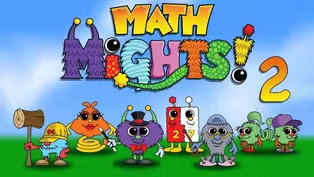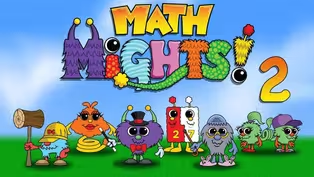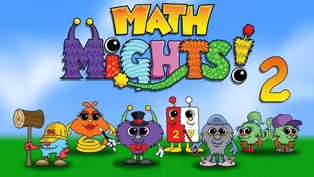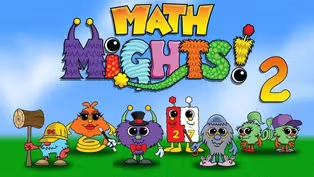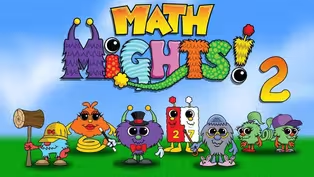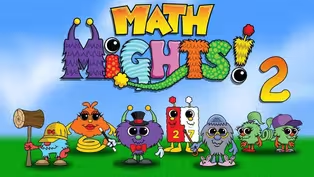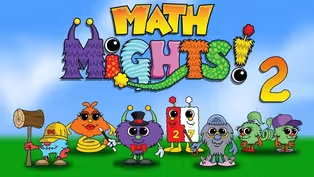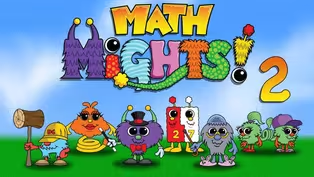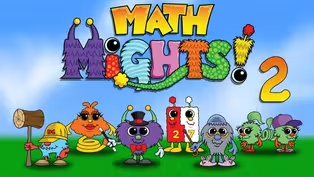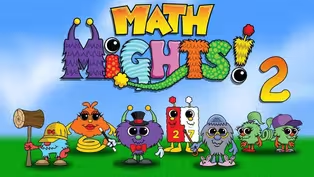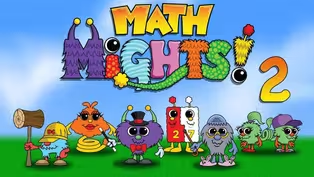Math Mights
Subtraction with 2-Digit Numbers Part 2
Season 2 Episode 216 | 16mVideo has Closed Captions
Join Mrs. McCartney for an addition number talk with D.C.!
Join Mrs. McCartney for an addition number talk with D.C.! Get ready to have some fun subtracting two-digit numbers with regrouping and renaming.
Problems playing video? | Closed Captioning Feedback
Problems playing video? | Closed Captioning Feedback
Math Mights is a local public television program presented by Detroit PBS
Math Mights
Subtraction with 2-Digit Numbers Part 2
Season 2 Episode 216 | 16mVideo has Closed Captions
Join Mrs. McCartney for an addition number talk with D.C.! Get ready to have some fun subtracting two-digit numbers with regrouping and renaming.
Problems playing video? | Closed Captioning Feedback
How to Watch Math Mights
Math Mights is available to stream on pbs.org and the free PBS App, available on iPhone, Apple TV, Android TV, Android smartphones, Amazon Fire TV, Amazon Fire Tablet, Roku, Samsung Smart TV, and Vizio.
Providing Support for PBS.org
Learn Moreabout PBS online sponsorshipMore from This Collection
"Math Mights" lessons for 2nd Grade students.
Video has Closed Captions
Join Mrs. McCartney for some fun with Professor Barble. (15m 59s)
Video has Closed Captions
Join Mrs. McCartney for some fun with Professor Barble. (15m 59s)
Video has Closed Captions
Join Mrs. McCartney for some fun with Professor Barble doing a tricky comparison. (15m 59s)
Video has Closed Captions
Join Mrs. McCartney for a word problem with Professor Barble that will make more sense. (15m 58s)
Video has Closed Captions
Join Mrs. McCartney for a comparison word problem with her friend Professor Barble. (15m 59s)
Compare 3-Digit Numbers Part 2
Video has Closed Captions
Join Mrs. McCartney to learn how to do a comparison word problem with Professor Barble! (15m 59s)
Comparing Numbers on a Number line
Video has Closed Captions
Join Mrs McCartney for a word problem with Professor Barble using Visula Models! (15m 59s)
Compare 3-Digit Numbers Part 1
Video has Closed Captions
Join Mrs. McCartney to see if we can figure out Professor Barble's comparison. (15m 59s)
Numbers represented in different ways
Video has Closed Captions
Representing numbers in different ways to show off your learning with place value. (15m 59s)
Video has Closed Captions
Put numbers together and taking them apart with expanded form. (15m 59s)
Video has Closed Captions
Join Mrs, McCartney for a Number Talk with her friend Springling! (15m 59s)
Video has Closed Captions
Join Mrs, McCartney for a Number Talk with her friend Springling! (16m)
Providing Support for PBS.org
Learn Moreabout PBS online sponsorship(playful music) - [Kids] Math Mights!
- Welcome back second grade math mights.
My name is Mrs. McCartney.
I'm so excited that you've joined us again today as we dive into some more strategies, looking at our math might friends.
Let's check out our plan for today.
We're gonna start off like we always do getting our brains ready with a number talk, and then we're gonna move into some subtraction strategies with two-digit numbers.
Let's think about as we enter into the idea of doing our number talk, we wanna hear different strategies about how you might be solving addition problems.
Let's see who we have up to talk about our number talk today.
Of course, it's our friend, D.C.
He wants us to continue practicing our strategy of decomposing to find friendly numbers.
Let's see what problem he has in store for us.
58 plus 19.
Let's think about that problem just for a minute.
This problem makes it hard to just count up on our fingers because we're adding too many.
Can you use the strategy of D.C. by decomposing one of the numbers to make a friendly decade number?
Let's see how Mia solved it.
Mia got really excited when she saw the number 19 because she knows that decade number 20 is only one away.
Let's check out how Mia solved the problem.
We have the problem, 58 plus 19.
She really wanted to make this 19, a 20, so she used the strategy of D.C. for addition and decompose the 58, giving one to that 19 to make it that nice, friendly 20.
If we take one away from our 58 we know that we're left with 57.
When we put 19 and one more together, we have a friendly number 20.
Mia finds it easy to add together with her tens quickly to get her 50 and 20, which is 70.
And then that other seven to get the total of 77.
Our friend, Matthew says that he agrees with the way Mia solved this problem but Matthew wants to show another way that he can solve this problem with D.C.. Let's check out how Matthew solved the problem.
Matthew thought of it really similar to Mia, but instead he wanted to make that 58, a 60.
Let's check out to see how Matthew solved the problem.
We have 58 plus 19.
Matthew really was looking at that 58 in D.C. strategy to make that a 60.
So he decided to decompose the 19, bring that two that he needed to be able to make that 58, a 60.
We take the two out of the 19, we know that we're left with 17.
Two plus 58 we know equals 60.
Plus the 17 makes this problem so much easier to add.
60 plus 10 more equals 70 or seven tens.
And then we have our seven ones to get that same answer that Mia got, 77.
Mia and Matthew did such a great job solving this problem.
I wonder how you solved this problem.
Let's take a look at our, I can statement for the day.
I can subtract two digit numbers with renaming and regrouping.
We're gonna battle out again with D.C. and T-Pops.
We have a Problem A and a Problem B that I want you to take a close look at.
What do you notice about Problem A?
I both wrote this horizontally and vertically for you to give a good comparison of the same problem.
And then I want you to look at Problem B.
What do you notice?
And what do you wonder about when you're comparing these two problems?
I know when I'm looking at these two problems I'm thinking that one of them might be a little bit easier for me to answer than the other.
Let's see what our friend thinks about this as she's kind of looked over both of these problems.
Mia says that this problem has no regrouping, so I know it's going to be easy.
How does Mia know there's no regrouping?
Let's look at that stacked problem, 45 minus 22.
If we start off with five, can we take two away?
Absolutely.
That's a really great indicator that that is a non regroup.
A very simple problem to subtract from.
I wonder what Matthew thinks about the way these problems look.
Matthew is looking at Problem B and thinks that we might run into some trouble as we start to look at the idea of using D.C. for this strategy.
Let's take a look at this problem, 53 minus 27.
And we used D.C. strategy of decomposing by place value.
I wonder what might happen.
If we went ahead and subtract our tens, it would be no problem.
50 minus 20, we know is 30.
But this is three takeaway seven.
Some of you might be able to use with your negative numbers but we're only in second grade.
If I only have three and I'm asking you to take seven away, can you do that?
No.
So Matthew's question is, "I wonder, how can we solve a problem like this using D.C.'s strategy?"
A great place to start to look at this problem is to look at 53 minus 27.
What's another way that we could say this?
We know we could say it as five tens and three ones, but what is another way that we could make the total still be 53, but say it in a different way?
When we think about this with renaming or regrouping, we are renaming numbers when we are regrouping.
We're not necessarily borrowing because if I borrowed your jacket you probably want it back later.
So sometimes we use a language with subtraction that might not make sense to you, but let's think about how we would rename the number 53.
If we were to look back at this to see, would it be okay if we said that 53 is also four tens and 13 ones?
Think about that for a second.
Four tens and 13 ones.
Does that still equal 53?
Well, in fact it does.
And that's one of the things that we're doing in the traditional method, but it's something that D.C. really wants you to understand.
Let's build this number on our mat so we can see what it looks like.
We're on our T-Pops' Place Value mat.
We're gonna build 53 with our place value disks.
I have the problem here written on our mat, 53 minus 27.
We wanna really act out what's happening with both D.C. and T-Pops.
We can make the connection of what we're really doing in the traditional method.
I'm gonna first do my five tens.
And then my three ones.
We know that we want on this side to be able to build that same number of 53 with D.C.
So we have the 53 here.
I'm just going to write this here the way that D.C. would look at it, 53 minus 27.
So you can kind of see a comparison.
We're still going to build that second number on the T-Pops' Place Value mat of 20 and seven.
We know if we wanna first take our seven when you take seven away from three.
Let's check out boys and girls what's gonna happen.
One, two, three.
Do I have enough to take this away?
I don't.
So let's think about it.
We had the total of 53.
I have to rename 53.
It was five tens and three ones but I'm going to take this 10 and I'm going to exchange it for 10 ones.
The reason I wanna do this is so I can actually take away those seven ones.
Right now I'm a little bit short.
I only can pull off three of those.
So by me renaming this number, I can go ahead and subtract this.
Boys and girls, is this still five tens and three ones if we looked at the disks that we have?
It isn't.
It's four tens and 13 ones.
So I'm gonna cross off my whole number 53.
I don't like to say that you're going next door to borrow because I didn't borrow anything.
Everything's still the same.
I'm not going to knock on the door and ask my friend next door to borrow one because I didn't.
I am physically renaming 53 as five tens and three ones.
I'm now naming it, four tens and 13 ones.
That's exactly what D.C. wants us to do.
When we talk about changing 53 we wanna be able to subtract it with D.C. strategy, so we need to decompose and rename 53, 40, and 13.
Do you see the connection?
40 and 13?
I see 40, and I see 13.
It's the same thing that you're doing in the traditional method.
Sometimes second graders learn T-Pops strategy too soon and they need to understand exactly what's going on in our problem.
So now we could take away our problem without any issues.
So let's go back over to T-Pops and see if we can use our 13 that we have here.
We wanna take away the seven.
We already took away three, four, five, six, seven.
We're gonna say, take this away and see what happens.
13 ones minus seven ones leave us with six.
Let's look at D.C. strategy, 13 minus seven gives us six.
Now we have 40 minus 20.
10, 20.
We're gonna take it away.
40 minus 20 or four tens minus two tens leaves us with two tens.
Same thing over here.
We look at D.C. strategy.
We now don't run into any problems.
40 minus 20 is 20.
And we're left over with this 26 to get our answer.
Do you see the connection between T-Pops strategy and D.C's?
Really helps us to understand the place value what's going on here.
Instead of saying things like borrowing, we're actually renaming and regrouping.
This is some hard second grade math but look how great you're doing.
Let's try another problem to see if we can solve it with both characters again.
We're gonna look at the problem, 63 minus 37.
Let's take a look at our T-Pops Place Value mat.
On this side, we're gonna show how T-Pops would solve the subtraction problem, 63 minus 37.
On this side, we're gonna show how D.C. solves it using the appropriate place value as he decomposes.
So I'm first going to build our first number in subtraction which we call it the menu end, which is 63.
So 10, 20, 30, 40, 50, 60.
One, two, three.
On D.C.'s side, I'm just gonna write the problem kind of horizontally so we can take a look at it this way.
63 minus 37.
I'm now gonna build the subtrahend down below with the place value strips to help T-Pops out as he solves this problem.
We have to take seven out of this three.
Do you think we're gonna be able to do it?
Let's see.
One, two, three.
Do we have enough ones with six tens and three ones to take away the seven?
We don't.
So in this case, we need to rename the number 63.
We're not gonna go next door and borrow one because it's not one, it's 10 and I'm not borrowing it.
I'm renaming it.
So let's take this 60 and rename this 10 as 10 ones.
I'm gonna put the 10 ones in the ones column to rename this number.
The value of it is still gonna total 63 and we can check it to make sure we just have changed the tens and ones to rename the number.
So now we have five tens and 13 ones.
Boys and girls, is five tens and 13 ones still equal to 63?
Actually it is.
So we're going to take and rename this number 63, five tens and 13 ones.
It's the same way that D.C. is gonna look at this because he knows we're gonna have a regroup.
He's going to decompose this number and back up a decade to rename it, 50 and 13.
This matches exactly what we've done in the traditional method and we're using the appropriate place value to understand exactly what we're doing.
We're gonna decompose the 30 in the seven because D.C. is not gonna have a problem now that we've renamed the numbers, just like T-Pops did.
Let's go back to this seven and we have to pull off seven total.
We've pulled off three, four, five, six, seven.
Once we pull all of these off, we can look to see our 13 ones minus our seven ones gives us six ones left.
So I can go ahead and write that here.
Same thing if I look at D.C., we just did this, 13 minus seven.
We know is going to give us six.
Now it's time to not do five minus three, but it's 50 minus 30.
So we need them to give us 30, 10, 20, 30.
Go ahead and take it away.
Five tens minus three tens gives us two tens to get our answer of 26.
Same thing over here.
If we do 50 minus 30 we end up getting 20.
If we add that together, we get the number 26.
Now it's time for you to try it on your own.
We're gonna give you two problems for subtraction that you can solve with D.C. and T-Pops.
You can show us your math might powers by being able to solve a problem with two different characters.
I'm so happy that you've joined us today, and I hope to see you next time on our Second Grade Math Mights.
Thanks so much for joining us.
(playful music) (playful music) - [Student] sis4teachers.org.
Changing the way you think about math.
- [Narrator] This program is made possible with funding from the Michigan Department of Education, Governor's Education Emergency Funds the State of Michigan, and by viewers like you.
(upbeat music)


- Home and How To

Hit the road in a classic car for a tour through Great Britain with two antiques experts.












Support for PBS provided by:
Math Mights is a local public television program presented by Detroit PBS
